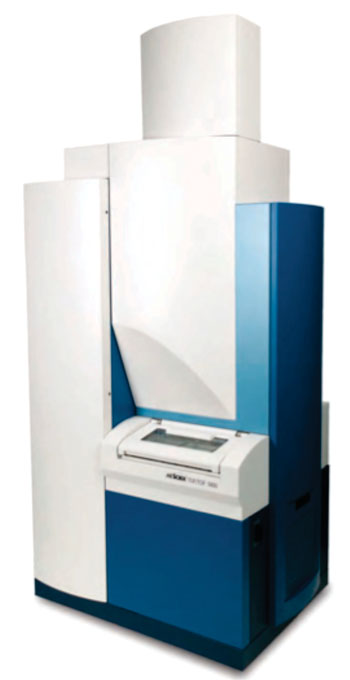New Method Diagnoses Deadly Fungal Lung Infection
By LabMedica International staff writers
Posted on 29 Dec 2015
A new way has been discovered for the early detection of a potentially deadly fungal infection in patients with suppressed immune systems such as those being treated for leukemia or have had an organ transplant. Posted on 29 Dec 2015
Patients receiving leukemia chemotherapy treatments, bone marrow stem cell transplants or lung transplants are some of those at risk for serious infection by the disease-causing Aspergillus fungus, a common mold in the environment that easily becomes airborne. When inhaled, the mold colonizes the respiratory tract and in patients with immune suppression from their chemotherapy treatment, the mold invades into the bloodstream where it spreads and infects several organs including the liver, lungs and brain.

Image: The AB Sciex 5800 MALDI TOF/TOF mass spectrometer (Photo courtesy of Sciex).
A multidisciplinary team led by scientists at The University of Texas Medical Branch (Galveston, TX, USA) enrolled patients undergoing chemotherapy, stem cell transplantation and lung transplantation in a multisite prospective observational trial. Proven and probable invasive pulmonary aspergillosis (IPA) cases and matched controls were subjected to discovery proteomics analyses using a biofluid analysis platform, fractionating plasma into reproducible protein and peptide pools.
Of the 61 IPA cases, serum galactomannan (GM) was assayed in 60, of which 36 tests were positive. Bronchoalveolar lavage GM was assayed in 35 cases of which 30 were positive. A positive serum GM was the only mycological criteria in 22 of the 61 cases. Independent testing of GM was performed on all IPA cases using serum collected on the same day as samples used for proteomics analysis. Those who developed probable or proven IPA where selected for subsequent proteomics studies.
For the 2D gel electrophoresis (2DE) spots that were significantly differentially expressed were picked robotically, trypsin-digested, and peptides identified by MALDI TOF/TOF (AB Sciex 5800; Foster City, CA, USA). Plasma concentrations of interleukin (IL)-6, -10, tumor necrosis factor (TNF)-α, plasminogen activator inhibitor (PAI)-1, Factor VIII, and Von Willebrand factor (vWF) were assayed by sandwich ELISA (Bioplex; Bio-Rad, Hercules, CA, USA). The Platelia Aspergillus enzyme immunoassay (EIA) (Bio-Rad Laboratories; Redmond, WA, USA;) was also performed.
From 556 spots identified by 2D gel electrophoresis, 66 differentially expressed post-translationally modified plasma proteins were identified in the leukemic subgroup only. This protein group was rich in complement components, acute-phase reactants and coagulation factors. Low molecular weight peptides corresponding to abundant plasma proteins were identified. A candidate marker panel of host response (nine plasma proteins, four peptides), fungal polysaccharides (galactomannan), and cell wall components (β-D glucan, BG) were selected by statistical filtering for patients with leukemia as a primary underlying diagnosis. The test results for the mold were different for each group of patients, so future commercial diagnostic tests using this technology should be tailored for different medical conditions commonly linked with this infection.
The authors concluded that they had confirmed, and evaluated a multicomponent predictive panel for the presence of IPA in a prospective cohort of immunocompromised patients in a multicenter registry. Two important findings are that host response proteins contribute independent information to that of GM or BG, and that diagnostic host response proteins of IPA are significantly influenced by the primary underlying disease. The study was published on November 18, 2015, in the journal Public Library of Science ONE.
Related Links:
The University of Texas Medical Branch
AB Sciex
Bio-Rad














